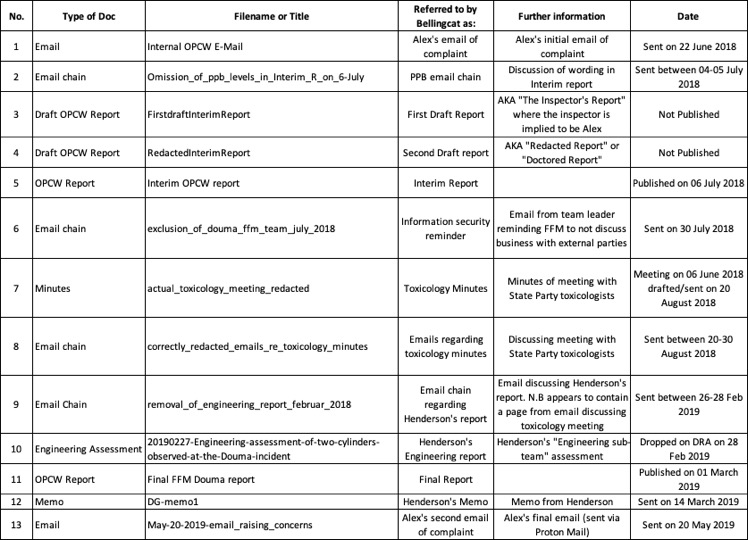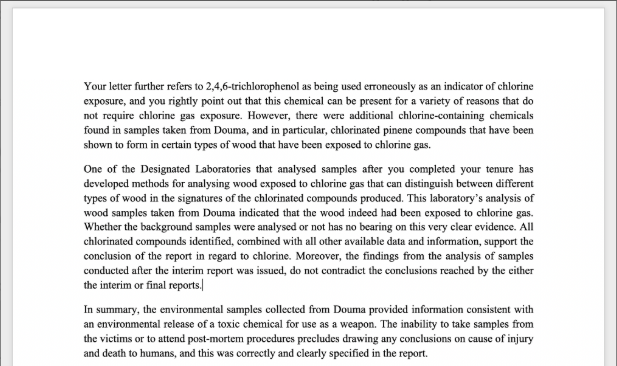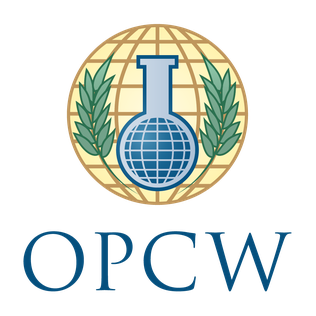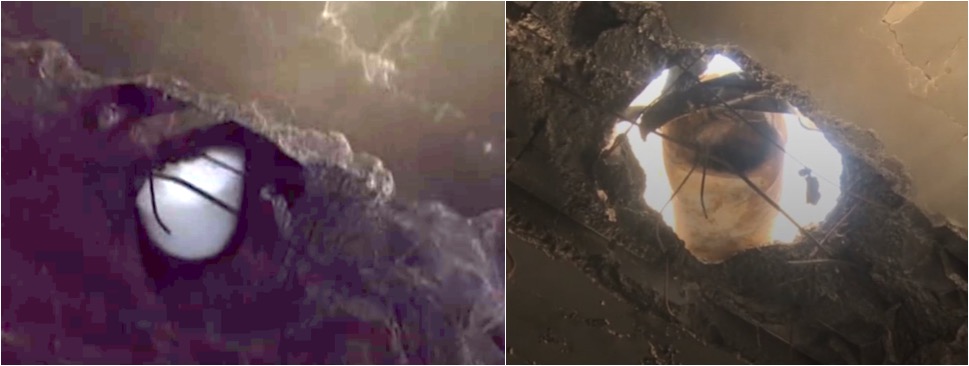The OPCW Douma Leaks Part 1: We Need To Talk About “Alex”
Executive Summary
- Some reporting of this situation has ignored the context of multiple chemical attacks perpetrated by the Syrian Government.
- Alex’s complaints are not properly placed in context.
- Alex’s claims about chemistry are flawed and hugely overstated.
- The stated conclusion of a meeting with toxicologists, which appears to support Alex’s claims, is inconsistent with known effects of chlorine inhalation.
- Alex has made misleading claims about this situation and the conclusions of subsequently leaked documents.
Over the past year the OPCW has dealt with multiple information leaks, all related to its investigation into the chemical attack on Douma, Syria in April 2018. Two employees have been associated with these leaks: Ian Henderson, who questioned the mechanics of the two cylinders falling from height, and an employee who has so far remained anonymous, who goes by the pseudonym “Alex”. In this article, we will examine Alex’s claims and the related documents leaked by WikiLeaks. In later articles, we will examine Henderson’s engineering report and other aspects of the case.
It should be noted that the events around the OPCW cannot be understood without the context of the pressure it has faced, primarily from the Russian Federation. In November 2017, the Russian Federation vetoed the extension of the Joint Investigative Mechanism (JIM), a joint UN-OPCW organisation which had a mandate to assign blame for chemical attacks. The JIM had carried out multiple investigations which found the Syrian government had used both chlorine and Sarin as chemical weapons, including the attack on Khan Sheikhoun, which killed scores of civilians. It also identified that ISIS had used sulfur mustard agent.
Several days after the attack in Douma, the Russian Federation deployed a GRU team to the Hague, which then attempted to hack into the WiFi network of the OPCW. It is possible there have been further attacks that we are not aware of. This of course raises the prospect that “Alex” is not in fact a real person, and these leaks are simply the Russian government using WikiLeaks to dump documents that they’ve hacked, in a similar fashion to the DNC leaks. However, multiple people claim to have met and talked to “Alex,” and such a scenario therefore seems very unlikely. In either case, the documents presented by WikiLeaks do appear to be genuine.
Chemical Weapons In Syria
These documents have been used by some actors to question the conclusions of the OPCW. Indeed, if one was to read the Mail on Sunday article, one would believe that this is a similar situation to the build up of the invasion of Iraq in 2003, with a “sexed-up dossier” used as evidence to justify said invasion.
To be clear, it is not. Chemical weapons have been used throughout the Syrian conflict, primarily by the Syrian government. Multiple independent and reputable investigations by various organisations, including the OPCW, the Independent International Commission of Inquiry on the Syrian Arab Republic, Human Rights Watch, Amnesty International and many others have been carried out. They all agree that the primary user of chlorine and the only user of Sarin has been the Syrian government. This government has used both these agents repeatedly over this conflict. Despite allegations against other parties to the conflict, the only other positively identified user of chemical weapons has been the Islamic State.

Chemical weapon attacks identified by the UN’s Independent International Commission of Inquiry on the Syrian Arab Republic
In the case of chlorine, attacks became so common in some areas that the munition remnants were simply collected in piles of munitions outside of town. The GPPi has collated information on credible reports of chlorine attacks here. They run into hundreds of examples.
Documents And Chronology
Many of the accusations against the OPCW have relied on readers not fully understanding the context of chemical weapons use in Syria. These accusations also fail to properly clarify what part of the investigation “Alex” was actually complaining about. The implication of the Mail on Sunday coverage is that Alex’s complaints reflect upon the final FFM Douma report. The Mail on Sunday only mentions a “fourth report” in passing.
This “fourth report”, which the Mail on Sunday mentioned once in its entire piece, is in fact the final and authoritative report. Alex’s complaints, and the leaked documents which have been used to support them, were not primarily about this final report. Alex’s original leaked email, is actually about various drafts of the interim report. These drafts were never intended to be the final report, because there was still so much left to investigate. Although Alex complained about the final report in a later interview, no internal FFM emails have been released in support of that statement.
The Mail on Sunday also caused confusion by referring to these reports as the “third” or “fourth” report. This is misleading. There are only two OPCW reports: the interim and final reports. The other two were draft documents. In the same way we would not ask our readers to judge this Bellingcat article on the basis of its drafts, judging the OPCW on the basis of its draft documents is at best shortsighted, at worst intentionally misleading.
In an attempt to remedy this we have provided a list of leaked documents in chronological order, including when they were drafted or published, if they were published at all. We have also included the officially published interim and final reports.

- Alex’s initial email of complaint
- PPB email chain
- First draft report
- Second draft report
- Interim OPCW report
- Information security reminder
- Toxicology minutes
- Emails regarding toxicology minutes
- Email chain regarding Henderson’s report
- Henderson’s engineering report
- Final report
- Henderson’s memo
- Alex’s second email of complaint email
What Is The Basis Of Alex’s Complaint?
The key point to bear in mind when examining Alex’s initial claims is that they are primarily focused on a set of two draft reports and an interim report that were drafted or published in late June and early July 2018 (entries 5, 6, and 7 in the above table).
The first draft report, also referred to as the “inspector’s report”, is implied to have been drafted primarily by Alex, while the second draft was a “management” re-draft, also referred to as the “redacted report”. Ultimately the head of the FFM wrote a further redraft which was published as the interim report. This interim report made no firm conclusion about the use of chlorine gas as a weapon in Douma.
This interim report was never meant to be the definitive report, and both the draft reports and the interim report explicitly note that further investigations are required. The final OPCW Douma report was completed 8 months and many other investigations later. Indeed the final report appears to have addressed, by either accepting or providing further information, many or all of Alex’s points.
It should also be borne in mind that at the time of writing, WikiLeaks had not yet released any internal FFM emails (as opposed to general OPCW emails) from after August 30, 2018. This leaves a 6 month gap where a huge amount of investigation, including a further deployment by the FFM, was conducted. It seems either WikiLeaks does not have emails from this period of time, calling into question how long Alex actually spent in the FFM, or the emails during this period do not support Alex’s view.
There is also, of course, the possibility that WikiLeaks will release these emails at a later date, however they remain an intensely opaque organisation and do not seem to be open about what material they have actually obtained. This makes it difficult to establish the truth of the matter, as WikiLeaks appears to be selectively releasing documents. Needless to say, we do not believe this furthers the cause of transparency or accountability.

Timeline of work from the final report. Note the work completed (in orange) that happened after the publication of the latest FFM email published by Wikileaks.
The Chemistry
Not only are Alex’s claims missing a huge amount of context, but some of them, including his technical analysis, are not as strong as presented by WikiLeaks and others. Our article, Chlorine’s Unique Fingerprints, goes through these arguments in detail, but we will examine some of the essential points below.
Much has been made of Alex stating that there were only “trace” quantities of chlorinated organic derivatives discovered, that could have come from a variety of other sources. The FFM accounted for this and deliberately gathered control samples in order to control for this. Indeed, “trace” quantities are in fact consistent with the amounts that would be expected from this kind of event.

Extract from final FFM report referring to molecular chlorine (Cl2)
One narrative that has taken on particular prominence is the idea that all of the identified chemicals can be found in household cleaning products. As far as we’re aware, this narrative was first explicitly mentioned by the Moon of Alabama, a conspiracy blog that has not previously demonstrated any kind of chemistry expertise. Previous posts by “b” on Moon of Alabama about the subject of Sarin are extremely simplistic.
This narrative is obviously flawed. Alex implied that some of the compounds discovered can be found in “household chlorine-based bleach”. However, these were found in samples taken at both Location 2 and 4, on multiple levels and on the adjacent street. Although it is possible that the inhabitants of Location 2 and 4 were in the habit of cleaning virtually everything in their buildings with bleach, including the walls and rubble in the street, it seems unlikely.
There is also the fact that the highest concentration of chlorinated organic compounds were found in a slat of wood underneath the cylinder on the bed at Location 4. This is the same kind of cylinder, with the same kind of unique modifications, which multiple independent investigations, including by the OPCW, have identified as being used on a regular basis in chlorine attacks. This is entirely unsurprising if the cylinder was indeed the source of chlorine gas.

Extract from final FFM report
Another indicator that Alex doesn’t even try to grapple with is the corrosion seen throughout both Location 2 and 4. When metal comes into contact with chlorine gas, it will start to corrode rapidly. Accounts from the First World War describe belt buckles turning black within minutes of chlorine attacks.
Extensive corrosion was seen and noted by the FFM.

Extract from final FFM report
Although the FFM noted that they could not be sure that this corrosion was not related to natural factors, we strongly believe it is related to the contents of the cylinders. Immediately after the attacks, the metal frame around the munition at Location 4 was relatively clean and did not show any clear corrosion (the metal frame at Location 2 was removed by the time the OPCW inspectors arrived). However, by the time the inspectors visited 18 days after the attack, the frame at Location 4 had become heavily corroded. It is clear that these munitions were exposed to something which caused rapid corrosion between the time of the attack and the visit of the FFM.

1: Still from video by Forensic Architecture, 2: Still from video by Forensic Architecture, 3: Image taken on 8th or 9th April, 4: image from Russian news report aired on 26th April, 5: image of cylinder in FFM final report, 6: image of cylinder in Final FFM report after tagging, indicating it was taken on the 3rd June 2018.
Note the progression of corrosion of the framework around the cylinder in the images above. Although dust in the earlier photos obscures some details, it is clear this framework underwent significant corrosion between the initial and final images.
Finally, it should also be noted that there is no single chemical or reaction that indicates the presence of chlorine gas. It is a combination of chemicals and effects, such as rapid corrosion, seen throughout both locations that undermines the notion that any other substance, in isolation, was responsible for their presence at Douma. A person throwing bleach around would not have achieved all these findings and effects. A far more detailed examination of this subject can be read here.
Toxicology: Symptoms
One of the documents that WikiLeaks has released is the minutes of a meeting with toxicologists from a State Party to the OPCW. The stated conclusion of this meeting was that the symptoms observed were inconsistent with chlorine, primarily due to the onset of frothing in a time period of 3-4 hours.
It should be noted that pulmonary edema, which can cause frothing, is a recorded symptom of chlorine gas inhalation. Events similar to Douma are extremely rare, but this graphic image from an industrial chlorine accident in China clearly shows similar “frothing” symptoms. Compare it with these graphic images of the victims at Douma.
What these toxicologists appear to believe is that the onset of that frothing was too rapid (3-4 hours) to be consistent with chlorine. The toxicologists also considered if there was the possibility that a different agent could have been used, but could not clearly identify alternative agents.
Although it is important to emphasise we are not toxicologists, we found it strange that it’s possible to find multiple accounts of chlorine gas causing relatively rapid frothing — primarily from the First World War. Although these accounts are old, they do describe situations where multiple people were subjected to extremely high concentrations of chlorine.
One medical journal we found from the First World War examines a gas attack in detail and notes the onset of frothing within about 90 minutes. The author of this book, the Colonel-Commandant of the Royal Army Medical Corps, in fact uses this frothing as an indicator the gas they were attacked by was primarily made up of chlorine rather than phosgene. The implication is, of course, that relatively rapid frothing is a known symptom of chlorine gas.

Extract from medical account of gas attack (p. 282)
Indeed, we also found recent academic references to Chlorine causing the rapid onset of pulmonary edema. This 2019 article on Chlorine Gas Toxicity stated “Pulmonary edema appears to be the most common cause of morbidity for moderate-to-severe exposures. This usually occurs within 2 to 4 hours of exposure to moderate chlorine concentration (25 to 50 ppm) or 30 to 60 minutes of severe exposure (greater than 50 ppm).” We have previously demonstrated that the concentration of chlorine within this building was likely to be well over 50 ppm.
We asked Professor Paul Blanc, who has extensive expertise regarding the adverse effects of chlorine gas on the human respiratory system, about the inconsistency between the conclusion of the toxicologists and the established manifestations of chlorine gas inhalation.
Professor Blanc was incredulous at the stated conclusions of the toxicologists as cited in these minutes. He noted that the onset of pulmonary edema can be quick, and can easily occur within 2-4 hours. In very heavy exposure to chlorine gas, defined by toxicologists as “immediately dangerous to life or health,” abrupt onset of respiratory distress would not be surprising, indeed, it would be expected. Although there are war gases with more delayed onset of symptoms (phosgene is classic), the hallmark of chlorine is its rapidity of action.
The first draft report also contained an error related to the symptoms seen in open source material. It noted that usually froth, when produced by choking agents, is usually pinkish in colour, but that the froth produced by the victims was “white or cream-coloured”.
Extract from first draft report
Not only have we shown that white froth does appears to have been a symptom in previous chlorine events, there are also images which clearly show victims with pinkish or brownish secretions. This is a detail which was noted by the FFM team and included in the final report.

Images of the victims depicting brownish or dark secretions. Extremely graphic sources: 1, 2, 3, 4, 5, 6
Toxicology: Actions Of The Victims
There is of course the possibility the toxicologists were not fully aware of the situation of Location 2 in Douma. For example, the experts opinion that it was:
“highly unlikely that victims would have gathered in piles at the center of the respective apartments at such a short distance from an escape from any toxic chlorine gas to cleaner air”.
This assumption is indicative of a lack of understanding of the context at Location 2 and of the Syrian conflict in general. Chemical attacks in Syria are so commonplace that people already know what to do in the event of one: head upstairs or to higher ground. Interviews conducted by the FFM demonstrate this very clearly:

Extract of Final FFM report.
Heading upstairs or to higher ground in an attempt to avoid chemical attacks has been recorded in FFM reports from incidents as early as 2014.

Extract from FFM report examining alleged chemical attack in 2014.
You can even see people being told to move upstairs and close the doors in this video depicting a chlorine attack in Aleppo.
It should be noted that an inverse form of survivorship bias is displayed here. In the final report, it was noted that:

Extract of Final FFM report.
Some people did move away from the source of the chemical, and survived as a result. Others did not. This is not inconsistent: considering the chaos of that night, with extremely heavy shelling and multiple reports of chemical attacks, staying put would not necessarily have been an irrational choice. It would have been far from clear to the victims where the source of the chlorine gas actually was.
None of the victims could have known a chlorine cylinder had actually landed on the building above them and was discharging its contents into the building they were in. Indeed, those casualties found on higher levels likely made the most rational choice in the circumstances, however, it was one that led them to their deaths. This appears to be confirmed by an interview with a witness. The witness claims to have been in the building and to have lost relatives to this attack. It should be noted that although he blames the rebels, he doesn’t elucidate how they carried out the attack, only noting the building was “hit”. As the journalist who interviewed him notes, blaming the Syrian government for a chemical attack whilst in government held territory would probably not be a wise decision. His statement deserves to be read in full:
“I sat in the basement when it happened; the house was hit around seven in the evening. We ran out, and women and children ran into the house. They didn’t know the house had been hit from above and was filled with gas. The one who ran into the house died immediately. I ran out, feeling dizzy”.
For these reasons, questions about why victims did not immediately move to cleaner air display a lack of understanding of chemical weapons use in Syria and the context of the attack in Douma that night. This lack of context may not be the fault of the toxicologists nor those members of the OPCW who spoke to them. The email chain discussing these toxicology minutes notes that the toxicologist’s insight “was (and had to remain) limited”. Considering the sensitivity of some of the information the FFM were dealing with, this is entirely understandable.
It should be noted that this single, one hour, meeting with toxicologists from a State Party should not be used as the basis for understanding the attack in Douma. As is noted in other leaks, these toxicologists had “limited” insight. There were multiple further toxicology consultations in both September and October, after the date of this specific meeting. Indeed, whoever drafted and sent the minutes for this meeting only did so on the 20th August 2018, two-and-a-half months after the meeting itself. Once again, Alex has asked us to draw conclusions with a very limited contextual picture.
Alex’s Misleading Statements
Finally, there is the question of Alex’s trustworthiness. So far all his communications have been through third parties, such as interviews. His true identity is not currently public knowledge. Brian Whitaker examined Alex’s statements and noticed that he has made misleading claims about the contents of the leaked material.
For example, Alex claimed that the First Draft report said that there had been “a non chemical-related event”. This is not true. As Whitaker notes, the First Draft did not say this: it stated that “a non chemical-related incident” in Douma was one of the possibilities considered, but that there was “insufficient evidence at this time to be able to formulate an authoritative conclusion”.
Alex also claimed that the report stated that “the signs and symptoms of victims were not consistent with poisoning from chlorine”, however the report only stated that some of the signs and symptoms were not consistent.
Alex also makes a great deal of Ian Henderson having been a member of the FFM. In his email on the 20th May 2019, Alex said “a member of the FFM team has been suspended from his post and escorted from the OPCW building”.
However, WikiLeaks also leaked an email chain regarding Henderson’s report showing in no uncertain terms that the OPCW did not regard Henderson as being part of the FFM. Bear in mind that at the time this email was written, Sebastien Braha, the Chief of Cabinet to the Director General of the OPCW, had no reason to believe this email would ever be public, and so no incentive to obfuscate Henderson’s status. We will examine Henderson’s status in more detail in our next article.
Conclusion
Ultimately, every time WikiLeaks has released documents, they have provided material which undermines Alex’s claims. Close examination of the contents of these documents show that Alex’s statement cannot be taken at face value and must be thoroughly checked. He has clearly misled people over the contents of the documents, the status of Henderson, and the strength of the evidence supporting his conclusions. Questions raised about the chemistry, toxicology and actions of victims in this attack have been thoroughly answered.
It is important to note that the selective releases from WikiLeaks so far do not cover the 6 months period during which a large amount of further investigation was carried out, including further consultations with toxicologists. Breathless headlines from the Mail on Sunday, the opinion section of The Independent, and from WikiLeaks themselves deliberately obscure this.
It is no wonder WikiLeaks seem reticent to leak the whole batch of documents at once: it appears likely that further information will continue to undermine their narrative.




